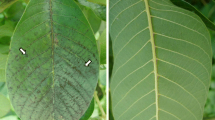Abstract
The fine structure of conidia, hyphae, and of isolated haustoria of cucumber mildew (Sphaerotheca fuliginea) was studied. Large vacuoles are present in the spores and hyphae. Rosette-shaped particles, presumably glycogen, occur in the spores. Certain haustoria were found which lack the protrusions of the central body of mature haustoria. Most probably these haustoria are young and not yet fully developed. Portion of the sheath membrane of these haustoria is in close contact with the central body wall. The observations suggest that the haustorial sheath membrane is formed as a specialized portion of the haustorial body wall. Presumably the formation of the sheath membrane precedes the formation of the sheath and that of the protrusions of the central body.
Samenvatting
Er werd een onderzoek verricht naar de submicroscopische structuur van conidia, hyphen en haustoriën, geïsoleerd uit komkommerbladeren die geïnfecteerd waren met echte meeldauw (Sphaerotheca fuliginea). Sporen en hyphen bevatten grote vacuolen. In de conidiën werden rozetachtige deeltjes, waarschijnlijk glycogeen, gevonden. Er werden ook haustoriën gevonden, waarbij de normaal voorkomende uitstulpingen van het centrale lichaam in volwassen haustoriën ontbraken. Bij deze waarschijnlijk jonge haustoriën is een gedeelte van de schedemembraan in nauw contact met de wand van het centrale lichaam. Deze resultaten doen vermoeden dat de schedemembraan gevormd wordt als een speciaal gedeelte van de wand van het centrale lichaam. Waarschijnlijk scheidt de membraan zich daarna van het centrale lichaam bij de vorming van de schede. Verondersteld wordt, dat de uitstulpingen van het centrale lichaam nà of tijdens de vorming van de schede ontstaan.
Similar content being viewed by others
References
Bracker, C. E., 1967. Ultrastructure of fungi. A. Rev. Phytopath. 5: 343–374.
Bracker, C. E., 1968. The ultrastructure of the haustorial apparatus of Erysiphe graminis and its relationship to the epidermal cell of barley. Phytopathology 58: 12–30.
Cochrane, V. W., 1958. Physiology of fungi. Wiley, New York.
Dekhuijzen, H. M., 1966. The isolation of haustoria from cucumber leaves infected with powdery mildew. Neth. J. Pl. Path. 72: 1–11.
Dekhuijzen, H. M. and Scheer, C. van der, 1967. Electron microscopic observations on haustoria isolated from cucumber leaves infected with powdery mildew. Neth. J. Pl. Path. 73: 121–125.
Dekhuijzen, H. M., Singh, H. and Staples, R. C., 1967. Some properties of hyphae isolated from bean leaves infected with the bean rust fungus. Contr. Boyce Thompson Inst. Pl. Res. 23: 367–372.
Dekhuijzen, H. M. and Staples, R. C., 1968. Mobilization factors in uredospores and bean leaves infected with bean rust fungus. Contr. Boyce Thompson Inst. Pl. Res. 24: 39–52.
Ehrlich, H. G. and Ehrlich, M. A., 1963. Electronmicroscopy of the sheath surrounding the haustorium of Erysiphe graminis. Phytopathology 53: 1378–1380.
Foerster, G. E., Behrens, P. Q. and Airth, R. L., 1965. Bioluminescence and other characteristics of Collybia velupites. Am. J. Bot. 52: 487–495.
Hirata, K., 1937. The haustoria of some powdery mildews. Ann. phytopath. Soc. Japan 6: 319–334.
Hirata, K., 1967. Notes on haustoria, hyphae and conidia of the powdery mildew fungus of barley, Erysiphe graminis f. sp. hordei. Mem. Fac. Agric. Niigata Univ. 6: 207–257.
McKeen, W. E., Smith, R. and Mitchell, N., 1966. The haustorium of Erysiphe cichoracearum and the host-parasite interface on Helianthus annuus. Can. J. Bot. 44: 1299–1306.
McKeen, W. E., Mitchell, N. M. and Smith, R., 1967. The Erysiphe cichoracearum conidium. Can. J. Bot. 45: 1489–1496.
Robinow, C. F., 1963. Observations on cell growth, mitosis and division in the fungus Basiobolus ranarum. J. Cell. Biol. 17: 123–152.
Shaw, M. and Manocha, M. S., 1965. The physiology of host-parasite relations. XV. Fine structure in rust-infected wheat leaves. Can. J. Bot. 43: 1285–1292.
Yarwood, C. E., 1950. Water content of spores. Am. J. Bot. 37: 636–639.
Author information
Authors and Affiliations
Additional information
The study has been carried out at the Laboratory of Phytopathology, State Agricultural University, Wageningen, in connection with the activities of TNO Research Unit for Internal Therapy of Plants.
Rights and permissions
About this article
Cite this article
Dekhuijzen, H.M., Van der Scheer, C. The ultrastructure of powdery mildew, Sphaerotheca fuliginea, isolated from cucumber leaves. Netherlands Journal of Plant Pathology 75, 169–177 (1969). https://doi.org/10.1007/BF02137213
Accepted:
Issue Date:
DOI: https://doi.org/10.1007/BF02137213




